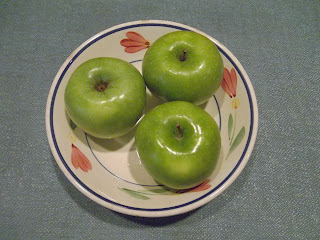 |
| "Granny Smith Apples" |
Thus begins the description in Grandma VandenBergh's Dutch cookbook of a series of recipes for something that I would never have thought of -- soups prepared from various kinds of fruits, including apples, pears, cherries, apricots and peaches.
There are almost identical recipes for apple soup and pear soup. Each calls for:
- 1 liter (4 1/4 cups) water
- 400 grams (2 1/4 cups) sour apples (or ripe pears)
- 50 grams (1/4 cup) sugar
- a piece of lemon rind
- about 10 grams (1 teaspoons) sago*
"Peel the apples, cut them in quarters and remove the cores. Set the fruit in boiling water with the lemon rind and simmer for 15 - 20 minutes. Stir in the sugar, remove lemon rind and thicken the soup. Optional -- pass the soup through a horsehair sieve and serve in a soup tureen."
 |
| Apple soup on the stove |
The pear recipe is similar, except that the cook is instructed to cut the pears into small pieces and simmer for about an hour. "If the pears are too bland, you may wish to add a bit of lemon juice or black currant juice when cooking. As for the apple soup recipe, you may wish to pass the soup through a horsehair sieve."
A horsehair sieve is obviously a relic of the past. Today's modern cook would use a food processor or a blender for the same purpose. I left my soup as is, with chunks of apple of various sizes floating in the juice, for a more interesting texture.
 |
| Apple Soup |
*Sago is a starchy product that comes from the pith of certain species of palm trees; you can substitute cornstarch in this recipe and no one will know the difference.









